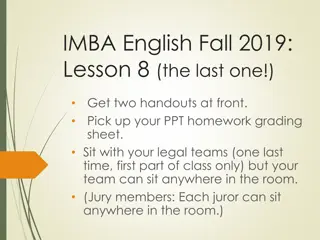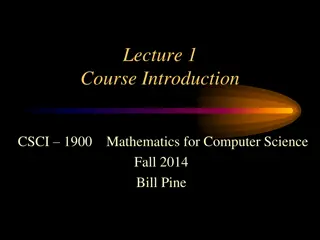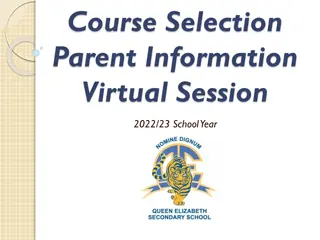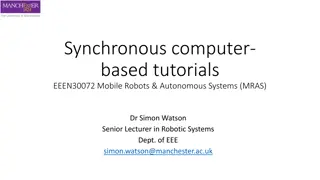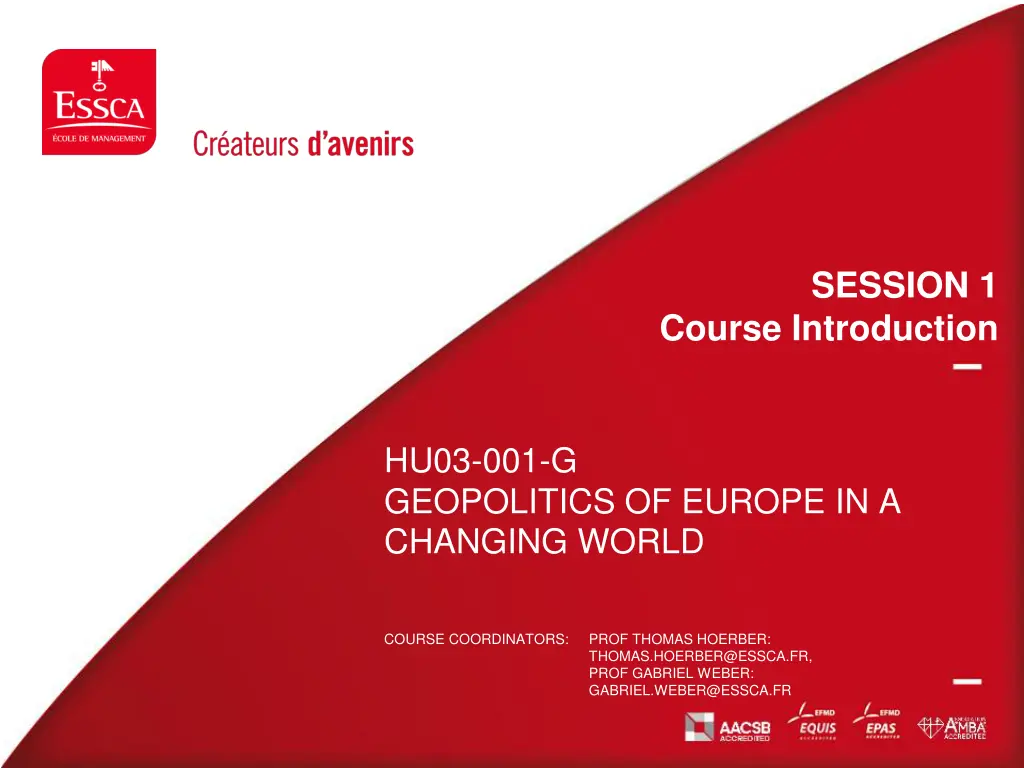
Geopolitics of Europe in a Changing World Course Details
Explore a course at ESSCA focusing on the evolving role of the EU in international relations. Dive into EU policies, institutions, and learning goals to enhance your understanding of European politics and public policies.
Download Presentation

Please find below an Image/Link to download the presentation.
The content on the website is provided AS IS for your information and personal use only. It may not be sold, licensed, or shared on other websites without obtaining consent from the author. If you encounter any issues during the download, it is possible that the publisher has removed the file from their server.
You are allowed to download the files provided on this website for personal or commercial use, subject to the condition that they are used lawfully. All files are the property of their respective owners.
The content on the website is provided AS IS for your information and personal use only. It may not be sold, licensed, or shared on other websites without obtaining consent from the author.
E N D
Presentation Transcript
SESSION 1 Course Introduction HU03-001-G GEOPOLITICS OF EUROPE IN A CHANGING WORLD COURSE COORDINATORS: PROF THOMAS HOERBER: THOMAS.HOERBER@ESSCA.FR, PROF GABRIEL WEBER: GABRIEL.WEBER@ESSCA.FR
EXTRACT FROM ESSCA STUDYS RULES Punctuality Students are expected to arrive on time in the classroom, i.e. before the start of the lesson Students who are late will not be accepted in class Use of telephones is strictly forbidden No use of telephones during the course whatever the reason given by the student Use of computers is not allowed during the course Students should have paper and pens to take notes by hand
COURSE CONTENTS 1) This course builds on the International Relations (IR) and Geopolitics courses in the first year at ESSCA and extents them to our immediate environment, the EU: The EU is one of the major actors in International Relations. The EU exercises its policies domestically and on the international stage. This course features therefore EU public policies, both with an international and internal dimension. It analyses how the EU implements policy, e.g. Multi-dimensional Stakes of European integration in the Cultural Industries; Erasmus exchange programme; Migration; Borders; European Governance on Platformization and Culture; European citizenship; Transport and Infrastructure; Armament and the European Defence Agency; Cyber Security; Large European research infrastructures: ITER, CERN; The Eurozone; The Common Agricultural Policy
COURSE STRUCTURE The course is divided into four parts: Part I The most important EU policies (8 sessions): (a) Introduction to the course (b) EU energy policy, EU sustainability policies, CFSP, CAP etc. (c) For more details see Practical Course Outline on Moodle Part II Excursion to a European Institution (2 sessions): (a) Civil Society, e.g. Maison d Europe (b) EU Agency, e.g. Community Plant Variety Office (c) European company, e.g. Airbus Part III EU policies la carte (4 sessions) (a) Erasmus, Football in European integration, European space policy (b) For more details see Practical Course Outline on Moodle Part IV Guest Lecture organisde by the EU*Asia Institute (1 session) (a) The impact of the Russia-Ukraine war on the EU Pied de page
LEARNING GOALS By the end of this course, students should be able to: (1) Students are able to analyse European Politics and Policies in oral and written form (2) Students are able to summarise one European public policy in an individual presentation. (3) Students can write academically about European politics and follow academic writing and referencing standards, as will be tested in an assignment of 500 words. (4) Students can, at the end of the course, write a short thesis (policy brief =1500 words) on European Public Policies in which they make informed arguments about a European public policy; Pied de page
LEARNING METHODS 1) Teaching resources what is expected from course instructors? Use of core texts related to the course Engage students in in-class discussions as a moderator Sharing your experience of European integration with the students Use of PPT presentations as background information 2) Active learning what is expected from students? Preparatory home reading of fundamental texts to be debated in class Students can be questioned individually or as the whole on their readings Individual presentation on the topic of a session registered in the List of Presentations for instructions see Guidelines for Presentations , both available on Moodle Preparation of a written assignment registered in the List of Assignments for instructions see Guidelines for Assignments , both available on Moodle The deadline is session 8 of the course Preparation of a written policy brief registered in the List of Assignments for instructions see Guidelines for Policy Briefs , available on Moodle The deadline is session 15 of the course Active and constructive participation in class with questions and analysis. Pied de page
COURSE EVALUATION 30% oral presentation of one subsection of a session for instructions see Guidelines for Presentations 20% Assignment (500 words) for instructions see Guidelines for Assignments 50% Policy Brief (1,500 words) for instructions see Guidelines for Policy Briefs All documents are available on Moodle in the Section General Pied de page
GUIDELINES FOR PRESENTATION In order to catch the attention and interest of your audience it is essential to present your topic in a free speech. It is usually helpful to have some notes to refer to. It depends on your personal style how detailed they are. A structured list of key points and related arguments which are fleshed out and explained during the presentation usually delivers good results. Handouts are usually a good way of providing your audience with basic information and the structure of your presentation. Structural elements such as bullet points, sequential numbers etc., are advisable. Give a short bibliography of the sources used at the end of the handout so that one can read up on presentation materials afterwards. Additional materials such as overhead foils, whiteboard or Power Point can be used, but should not be overemphasized. The presenter and the contents must remain the dominant elements of the presentation. Usually it works well, if you stand up and present in front of the class. The presentation should be 10-15 minutes long. Pied de page
THE MOST IMPORTANT THING ABOUT YOUR PRESENTATION Clearly all the above points are no strict rules. Feel free to experiment and find your own way to put your arguments across in the most convincing way. The most important criterion for grading will be the effort and the attempt to give a good presentation. Clear presentation of contents and the attention of class normally result from this effort and will, therefore, form the basis of the evaluation.
GUIDELINES FOR ASSIGNMENTS I. General requirements 1. The Economic Security assignments are an exception. The deadline for these assignments will be Session 7 of the course. 2. Aim for about 500 words. 3. Usually a threefold structure of Introduction/Interpretation/Conclusions is a good way of providing an analysis of both primary and secondary sources. 4. Use the assignment marking grid to prepare a summary of a subsection of the chapter you have chosen in the List of Assignments. 5. Make proper academic references and write in good English Pied de page
GUIDELINES FOR ASSIGNMENTS II. Introduction 1. Give the author, title and the year of publication of the source in the introduction of the paper. 2. Examples of the right quotation techniques of sources can be found in the Guidelines for Policy Briefs. III. Interpretation 1. Describe the topic of a subsection of the chapter you have chosen; the different positions which are mentioned in the subsection and their interpretation by the author. 2. Analyse the subsection and provide you own knowledge of how the topic can be interpreted. If, in this context, you know other authors or sources that have dealt with the topic, mention their positions and give a reference. IV. Conclusions 1. It will usually not be necessary to consult other sources than the respective chapter. 2. However, if you want to include the opinion from another secondary source, present the source clearly with a reference.
THE MOST IMPORTQNT POIUNT ABOUT THE ASSIGNMENT In the conclusion one can comment on whether the text was easily accessible; on the possible audience for the text; on the outlook or the political motivations of the author, or on the main arguments of the author, if that has not happened in main body of the paper. Importantly, the conclusion is your own particular contribution. Try to give an opinion, your impressions of the text and what you took from it the
GUIDELINES FOR POLICY BRIEFS A policy brief is a concise summary of a particular issue, the policy options to deal with it, and some recommendations on the best option. It is aimed at government policymakers and others who are interested in formulating or influencing policy. General requirements 1. The deadline to choose a topic is: Session 8 2. The deadline for submission is: Session 15 3. Aim for 1500 words Pied de page
GUIDELINES FOR POLICY BRIEFS Choose one of the European Policies discussed in this course and propose the topic to your professor. Examples of policy briefs (see Sample1 and Sample 2 on Moodle Bibliography is excluded from the word limit. You can choose any topic that falls within the scope of the course. For all topics speak to the professor who teaches the course to get advice and his/her approval of the topic. Detailed Guidelines for Policy Briefs can be found on Moodle under General/Instructions for Policy Briefs
GUIDELINES FOR POLICY BRIEFS Required content: 1. Give the title of the policy brief. 2. Provide the reader with an executive summary of the problem and proposed action. 3. Explain in 1-2 paragraphs the problem. Define the problem. Describe the scope of the problem (local, regional, national, European). Explain why the problem requires policy action, that is the social, environmental, and economic effect. 4. Explain in 2-3 paragraphs the alternatives for action and assess their advantages and disadvantages. Do research about the policies that have been implemented to solve similar problems. This research can go beyond Europe, that is, you can use policies that have been used in other regions. Assess the advantages and disadvantages of applying such policies to the problem you have chosen. 5. Finish with 1-2 paragraphs with a policy recommendation: Justify the implementation of one of the alternatives for action and explain how it can be implemented. Consider the economic, environmental, and social cost to justify your recommendation. 6. When relevant, you may use figures or graphs to illustrate your analysis or provide a synthetic presentation of complex matters 7. Add a reference list.
GUIDELINES FOR POLICY BRIEFS Required format: 1. Include: Title, your name, the course name and number, the instructor s name, and the due date. 2. Use 1.5 line spacing and 12 font size 3. Insert page numbers 4. Organize the content with headings and subheadings. 5. For the basic rules of referencing please read: https://owl.purdue.edu/owl/research_and_citation/apa_style/apa_formatting_ and_style_guide/reference_list_basic_rules.html 6. For examples of referencing please read the following sample paper: https://owl.purdue.edu/owl/research_and_citation/apa_style/apa_formatting_ and_style_guide/apa_sample_paper.html
GUIDELINES FOR POLICY BRIEFS Submitting your essay 1. The file name of your brief should include your name. 2. Send the essay as attachment to Dr. Thomas Hoerber (Thomas.Hoerber@essca.fr) 3. For plagiarism assessment, add as cc (groupe.essca@analyse.urkund.com) 4. Give a paper copy to the professor teaching your course 5. Please read the excerpt of the essay marking grid below to understand how you are evaluated
ANTI-PLAGIARISM REGULATION What is plagiarism? Plagiarism is the act of taking another person s thoughts and passing them off as your own (Le Larousse definition) It occurs when a student copies abstracts or the whole text from the original source without paraphrasing or summarizing them, and without quoting the authors of these texts Plagiarism can be considered as a kind of legal infraction of the author s rights How is plagiarism sanctioned? In case of detected plagiarism in the written dossier, the grade given to the whole group should be 0 regardless of the quantity of information that has been plagiarized. In this case, the group s final grade will be the average of the grade of 0 and the grade for the group s oral presentation
EXTRACT FROM ESSCA STUDYS RULES Plagiarism Plagiarism is strictly forbidden in all types of work If plagiarism is proven the work in question will be marked 0 and the administration will convene the Disciplinary Board Class attendance is obligatory Students must attend all classes Work asked by the Professor should be done Hard work leads to success
MAIN SOURCES TO BE USED BY ALL STUDENTS IN THIS COURSE Hoerber T., Weber G., Cabras I. (2021) The Routledge Handbook for European Integrations, Routledge London E-book available in the ESSCA M diath que under: The Routledge Handbook of European Integrations / Thomas HOERBER Cat gorie de document : EBOOK Publication : Routledge, 2021 Ressource en ligne : Cliquer ici
HOMEWORK Students must read the respective chapter for each session before class. Prepare a table of contents on one of the subsections of the chapter for possible interrogation in class. Prepare questions for class For Session 2 read The United States of Europe and new horizons for European integration , in: Hoerber T., Weber G., Cabras I. (2021) The Routledge Handbook for European Integrations, Routledge London, pp. 1-10
THE SCHUMAN DECLARATION 9 MAY, 1950 Read the Schuman Declaration in class (available on Moodle/General, last document in the list) Think about the historical background in 1950 Think about the situation in France / Germany / Europe Prepare questions
QUESTIONS ON THE SCHUMAN DECLARATION What makes up the Foundation ideas of Europe Who is at the Centre of Europe? How will European Integation work?
CONCLUSION ON THE SCHUMAN DECLARATION 9 MAY, 1950 What makes up the Foundation ideas of Europe Peace & Prosperity Who is at the Centre of Europe? France & Germany How will European Integation work? Step-by-step; practical solutions; building real trust Conclusion: Economic integration Prosperity political freedom of action of integrated countries political integration between these countries peace European integration uses economic means for political ends
THANK YOU FOR YOUR ATTENTION ANY QUESTIONS?











